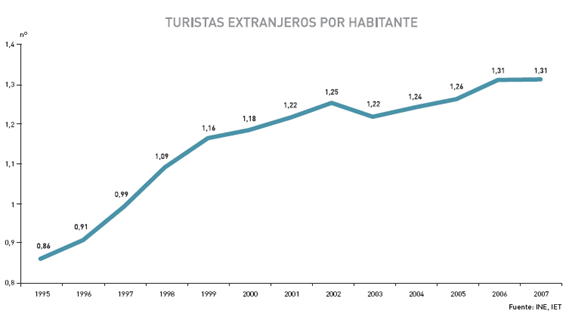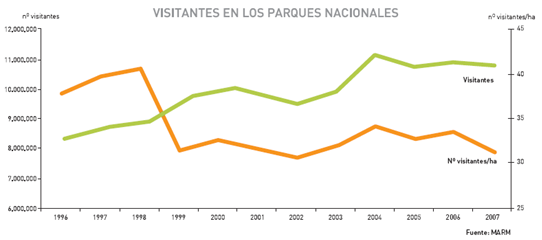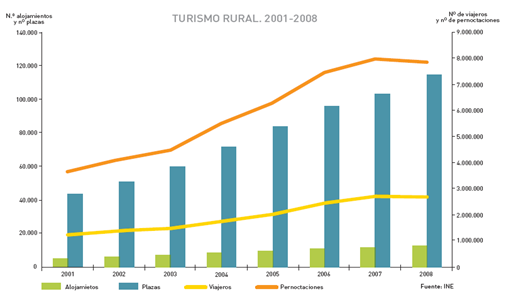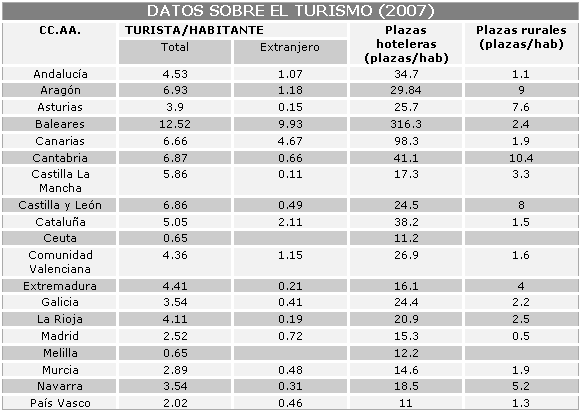Turism
- TOURIST POLICY IN SPAIN
- DATA ON THE TOURISM IN SPAIN
- OTHER INFORMATION AND DOCUMENTS OF INTEREST
- READ MORE
More than forty-five million of tourists visit Spain every year, causing that this country is one of the three more visited countries in the world.
The dominant tourism model in Spain is a model of sun and beach tourism, highly seasonal.
Froman economic standpoint, tourism in Spain is a very important activity (approximately represents 11% of the PIB) and is in continuous growth.
Furthermore, the arrival of tourists means more consumption of resources and energy, a greater amount of waste generated, more infrastructures to give services, greater land use…, is essential, to have it in account for the correct management of the hydric resources, considering on one hand the effect of seasonal and spatial displacements (entails an increase of the hydric resources very precise and concentrate) and the emergency of leisure activities, tourist and recreational (hiking, navigation, fishing, baths, etc.)
The tourism doesn´t require elevates volumes of water in total, although the volumes per capita are very superiors to the average, and the tourist model in Spain is moving towards a more diversified tourism that seeks new consumer products: nature, culture and active tourism.
The seasonality of the demand and the concentration of second homes with very low occupancy rates, demand the over-sized of the distribution and purification networks.
On the other hand, the diversification of the tourist supply by the development of additional offerings like thematic parks, golf courses, recreational ports… constitutes an important demand of hydric resources. In absolute terms, the 361 existing golf courses in 2004 consumed 124 hm3, 45% of the total tourism consumption for all type of lodging.
TOURIST POLICY IN SPAIN
The tourist policy in Spain is developed in the General Secretariat of Tourism and Domestic Trade, that depends on the Ministry of Industry, Tourism and Trade through the following entities (autonomous organisms and public entities):
The Institute of Tourist Studies is a dependent Organism of the Ministry of Industry, Tourism and Trade.
According to the established by Royal Decree 1182/2008, of 11 July, is responsible for "the investigation of the factors that affect the tourism, as well as the elaboration, compilation and evaluation of statistical information and data on tourism" (Art. 14d.).
![]() Tourism Institute in Spain (TURESPAÑA)
Tourism Institute in Spain (TURESPAÑA)
The Tourism Institute of Spain (TURESPAÑA) is dedicates to the promotion and commercialization of the Spanish tourism.
TURESPAÑA provides tourist information, especially to the potential foreign visitors through the Web.
![]() SEGITTUR (State Society by the Innovation management and Tourist Technologies)
SEGITTUR (State Society by the Innovation management and Tourist Technologies)
The purpose of this State Society is to support the tourist promotion and the commercialization of products and services through the use of new technologies, with particular emphasis in Internet.
DATA ON THE TOURISM IN SPAIN
According to data of the latest edition of the "Environmental Profile of Spain 2008", in 2007, the country welcomed to the tourists who mostly came from three countries: United Kingdom, Germany and France.
Catalonia, the Balearic Islands, Andalusia, Valencia and Madrid, were the Autonomous Communities that received to this flow of tourists (concentrating the 90.5% of the total). Highlights the significant reduction of tourists in the Cantabrian coast and some inland communities.
On the other hand, the residents in Spain made a total of 146.8 million trips within the country (93.58%), and 11.3 million trips to the foreigner (6.42%). The main destination for Spanish tourists in the country is Andalusia, followed by Catalonia and Valencia. As for foreign travel, the main destination (76.8%), are located in Europe (France, Portugal, Italy and Andorra)
The following graphs give an idea of the role that the tourism carries out in Spain (Population, Environment, Rural)
![]() Tourism and Population: Number of Foreign Tourists by Inhabitant
Tourism and Population: Number of Foreign Tourists by Inhabitant


Figure 1: Foreign tourists per capita. Source: Environmental Profile of Spain 2008. Report based on indicators
As we can see, the arrival of tourists presents a tendency in continuous increase.
Baleares (with 9.93 foreign tourists by inhabitant), the Canary Islands (with 4.67) and Catalonia (with 2.11), surpass the national average in the number of tourists by inhabitant.
The following graph indicates the number of nights of tourist stay in the time period between the years 2001-2007, according to various tourist accommodations.
![]() Tourism and Environment: Number of Visitors to National Parks
Tourism and Environment: Number of Visitors to National Parks


Figure 2: Number of visitors to National Parks. Source: Environmental Profile of Spain 2008. Report based on indicators
Since 1996, 10 million visitors have visited the Spanish National Parks. The National Parks most visited, have been, Garajonay, Teide, Timanfaya and Caldera de Taburiente
![]() Rural Tourism: Accommodation, Places, Tourist and Overnight Stays
Rural Tourism: Accommodation, Places, Tourist and Overnight Stays


Figure 3: Rural tourism. Years 2001-2008. Source: Environmental profile of Spain 2008. Report based on indicators
At present, the rural tourism, with a strong environmental character, contributes to the establishment of the rural population, to the growth of the agrarian rent, to the conservation of nature and to the preservation of historical and cultural patrimony.
In the period 2001-2008, the rural tourism in Spain presents a remarkable development; so in 2007, the rate of rural accommodations increased a 9.61%. This increase contrasts with a decrease of -1.93% in the annual rate of travel, and in the overnight stays, with a diminution of -2.32% (decrease that only affected the Spanish travelers, not to the residents outside Spain).
The majority of the passengers who use rural accommodations are Spanish or residents in Spain, with stays of short duration, ranking the average stay in these accommodations in 2.99 days.
Castilla y Leon, Catalonia, Asturias, Andalusia and Castilla-La Mancha, with 2543, 1516, 1186 1172 and 1005 respectively, are the communities with the greatest number of rural accommodations.
OTHER INFORMATIONS AND DOCUMENTS OF INTEREST
![]() Plan of Spanish Tourism Horizon 2020
Plan of Spanish Tourism Horizon 2020
![]()
The Spanish Tourism in numbers. Year 2007 (Source: Institute of Tourist Studies. Ministry of Industry, Tourism and Commerce)
![]() Data from INE (National StatisticsInstitute)
Data from INE (National StatisticsInstitute)
Occupation of tourist lodgings
![]() Environmental Profile of Spain 2008. Report based on indicators
Environmental Profile of Spain 2008. Report based on indicators
READ MORE

Table 1: Data on the Tourism by Autonomous Communities




